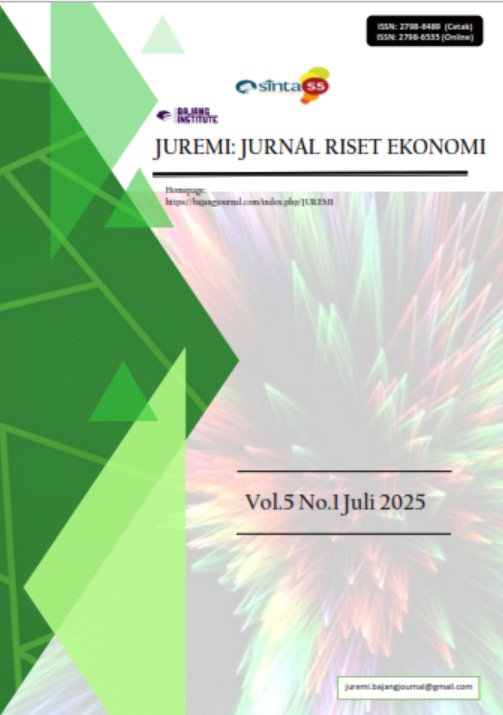ANALYSIS OF THE INFLUENCE OF THE NUMBER OF STUDENTS AND TOURISTS ON THE ROOM OCCUPANCY RATE IN BALI
DOI:
https://doi.org/10.53625/juremi.v5i1.10962Keywords:
Number Of Students, Tourist Visits, Room Occupancy RateAbstract
Tourism is a key sector in Bali's economy, with industry growth influenced by various factors, including the presence of tourism students. This research aims to analyze the correlation between the number of tourism students and the level of tourist visits and room occupancy in Bali's tourist destinations. The method used is secondary data analysis from various relevant sources, including tourism statistics, higher education data, and hospitality industry reports. The results show that the number of tourists is the most influential variable on room occupancy rates, whereas the number of students does not show a significant effect on either occupancy or the number of tourists. These findings emphasize that in the context of destination management like Bali, tourism activities remain the main driver of the accommodation industry, not educational activities. This research provides important insights for strengthening sustainable tourism strategies while still considering the synergy between the education sector and the tourism industry
References
Abelha, M., Fernandes, S., Mesquita, D., Seabra, F., & Ferreira-Oliveira, A. (2020). Graduate Employability and Competence Development in Higher Education—A Systematic Literature Review Using PRISMA. Sustainability, 12, 5900-5900. https://doi.org/10.3390/su12155900.
Akat’eva, L., & Rogozina, E. (2021). FORMATION OF PROFESSIONAL COMPETENCE OF A TOURISM MANAGER. Bulletin of Udmurt University. Series Philosophy. Psychology. Pedagogy. https://doi.org/10.35634/2412-9550-2021-31-4-454-462.
Badan Pusat Statistik. (2024). Statistik Pariwisata Indonesia 2024. Jakarta: BPS Indonesia.
Badan Pusat Statistik. (2024). Statistik Wisatawan Mancanegara. Jakarta: BPS Indonesia.
Calvo, D., Nofre, J., & Fuarros, I. (2024). Unveiling the intersections between tourism industry and student mobility. Population, Space and Place. https://doi.org/10.1002/psp.2752.
Choe, Y., & Kim, N. (2024). From the classroom to the Living Lab for developing competencies in tourism higher education. Journal of Hospitality, Leisure, Sport & Tourism Education. https://doi.org/10.1016/j.jhlste.2024.100511.
Croes, Manuel Rivera (2016). TOURISM AND HUMAN DEVELOPMENT Robertico.
Descals-Tormo, A., & Ruiz-Tamarit, J. (2022). Tourist choice, competitive tourism markets and the effect of a tourist tax on producers revenues. Tourism Economics, 30, 283 - 300. https://doi.org/10.1177/13548166221145081.
Descals-Tormo, A., Murgui-García, M., & Ruiz-Tamarit, J. (2024). A new strategy for measuring tourism demand features. National Accounting Review. https://doi.org/10.3934/nar.2024022.
Douglas, N., Douglas, N., & Derrett, R. (2001). Special Interest Tourism. John Wiley & Sons.
Goeldner, C. R., & Ritchie, J. R. B. (2011). Tourism: Principles, Practices, Philosophies. John Wiley & Sons.
Hailong Ma (2025). Analysis of Technical Pathways for Aligning the Teaching Quality Standards of National First-Class Tourism Management Programs with International Benchmarks. Progress of Chinese Pedagogy. https://doi.org/10.48014/pcp.20250216002.
Kenna, T., & Murphy, A. (2021). Constructing exclusive student communities: The rise of “superior” student accommodation and new geographies of exclusion. The Geographical Journal. https://doi.org/10.1111/GEOJ.12380.
Kinton, C., Smith, D., & Harrison, J. (2016). De-studentification: emptying housing and neighbourhoods of student populations. Environment and Planning A, 48, 1617 - 1635. https://doi.org/10.1177/0308518X16642446.
Lee, S., Croes, R., & Rivera, M. (2013). UNDERSTANDING QUALITY OF WORK LIFE OF HOTEL EMPLOYEES. , 2013, 104-104.
López, X., Fernández, M., & Incera, A. (2016). The Economic Impact of International Students in a Regional Economy from a Tourism Perspective. Tourism Economics, 22, 125 - 140. https://doi.org/10.5367/te.2014.0414.
McGladdery, C., & Lubbe, B. (2017). Rethinking educational tourism: proposing a new model and future directions. Tourism Review, 72, 319-329. https://doi.org/10.1108/TR-03-2017-0055.
Michael, I., Armstrong, A., & King, B. (2004). The travel behaviour of international students: The relationship between studying abroad and their choice of tourist destinations. Journal of Vacation Marketing, 10, 57 - 66. https://doi.org/10.1177/135676670301000106.
Page, S. J., & Hall, C. M. (2003). Managing Urban Tourism. Pearson Education.
Rasool, R. (2024). The Role of Educational Tourism in Developing The Local Economy (A Study of A Sample of Students Arriving at Karbala Technical Institute). International journal of tourism and hospitality management. https://doi.org/10.55640/ijthm-04-02-06.
Reynolds, A. (2020). Geographies of purpose built student accommodation: Exclusivity, precarity and (im)mobility. Geography Compass, 14. https://doi.org/10.1111/gec3.12543.
Saepudin, D., Nurdin, D., Fajri, I., & Permana, D. (2022). Peningkatan Kualitas Sdm Pariwisata Melalui Pendidikan Terintegrasi: Kolaborasi Perguruan Tinggi Vokasi Dengan Industri Pariwisata. Barista: Jurnal Kajian Bahasa dan Pariwisata. https://doi.org/10.34013/barista.v9i02.1082.
Saepudin, D., Sa'ud, U., Nurdin, D., & Kurniatun, T. (2023). Integrated Quality Management Model of Learning Practices in Tourism Vocational Higher Education. AL-ISHLAH: Jurnal Pendidikan. https://doi.org/10.35445/alishlah.v15i4.3769.
Simpeh, F., & Shakantu, W. (2020). An on-campus university student accommodation model. Journal of Facilities Management, 18, 213-229. https://doi.org/10.1108/jfm-03-2020-0017.
Tomasi, S., Paviotti, G., & Cavicchi, A. (2020). Educational Tourism and Local Development: The Role of Universities. Sustainability, 12, 6766. https://doi.org/10.3390/su12176766.
















